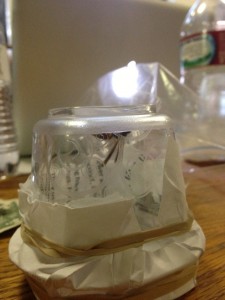When I was at home in Dallas over this Thanksgiving breaking, I noticed that the weather was unusually warm, or at least not as cold as other Thanksgiving weekends I have experienced in the past. I also saw an unusually large amount of insects for this time of the year, and I imagine that it is partly because of the unusually warm temperatures.
Having done a bit of research into the matter, it is not surprising, then, that insect abundance and distribution are partly regulated by abiotic factors, chiefly temperature and humidity (http://www.hindawi.com/journals/psyche/2012/167420/). Both of these factors were noticeably well above average for this time of year in Dallas.
A study by E. Muller and E. Obermaier observed the effect of daily exposure to a variety of temperatures on the beetle species Galeruca tanaceti, with results indicating that average temperatures close to or below the developmental threshold retard development and in many cases increase mortality (http://www.hindawi.com/journals/psyche/2012/167420/). I saw an unusual abundance of insects for the time of year, but the insects did not look very healthy at all. I hypothesize that this warm front ‘tricked’ the insects into thinking that spring was already here, and the lack of consistent, sustained warm temperatures along with predictable undernourishment caused the larvae to result in unhealthy adults.
Another study led by E. Penarrubia-Maria explored how long into winter the Mediterranean fruit fly, Ceratitis capitata, would persist. Results indicated that this species of insect was unable to withstand temperatures once they dropped below freezing (http://www.hindawi.com/journals/psyche/2012/497087/). I find it fascinating that the presence of insects in the later months of fall can be used to determine how cold of a fall a habitat endured, even if one has not even been in the habitat. Based off of my observations, I can predict with confidence that Dallas has had a warmer fall than usual with temperatures failing to fall below freezing. I checked a history of Dallas weather, and I was almost right. The temperatures had fallen below freezing only once (http://www.accuweather.com/en/us/dallas-tx/75201/november-weather/351194?monyr=11/1/2013). Ceratitis capitata, the model insect used in the study by Penarrubia-Maria, thus may exhibit slightly higher threshold temperatures than the insects in Dallas, Texas, but the general relationship of insects with cold temperatures seems to hold true.
My most notable encounter with an insect over break occurred when I observed a noticeably malnourished wasp crawling on a window in my house. I took this as an opportunity to add to my insect collection for the lab portion of this class, but unfortunately, I did not have a kill jar at my disposal. So I was forced to make a makeshift kill jar:
This particular wasp, I believe, is a polistine paper wasp. Because food resources are particularly scarce for wasps once late November and December roll around, it was not surprising that this wasp was visibly low in energy, as it exhibited little ‘fight’ once caught.


